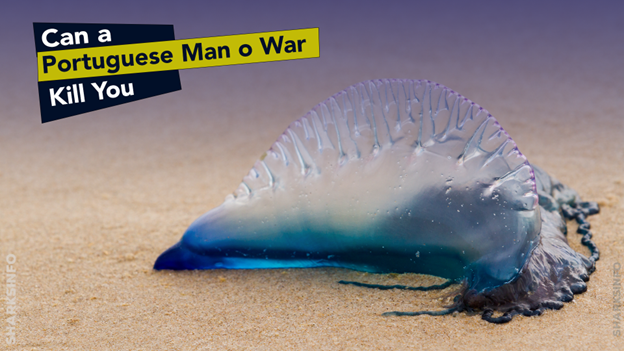The ocean is full of unusual species of fish and animals that are extremely diverse in their characteristics. The Physalia physalis, or the Portuguese Man o’ War, is one such species. The Portuguese Man o’ War is repeatedly thought to be a jellyfish, but it is not true jellyfish. Although it is closely related to jellyfish, it is actually a siphonophore. As the species differ, their characteristics will also differ. So, in this article, we’ll be discussing some characteristics of the species and whether a Portuguese Man o’ War can kill you or not.
To distinguish the Portuguese Man o’ War from jellyfish, we can look at a number of their characteristics. Siphonophores, for example, are an unusual class of species. Let’s discuss some of the characteristics of siphonophores, particularly the Portuguese Man o’ War, to understand the difference.
How is the Portuguese Man o’ War Identified?
As mentioned above, the Portuguese Man o’ War is a siphonophore. Siphonophores are a species that has a colony of specialized individuals that are genetically identical. These genetically identical individuals work together as one with their various forms and functions. The Portuguese Man O’ War is composed of four individuals. Each one of them has a dissimilar purpose. These purposes are reproduction, feeding, floating, and capturing prey. They are mostly present in steamy and subtropical areas.

Now that we are aware of identifying a Portuguese Man o’ War, let’s come to the big question; can a Portuguese Man o’ War kill you?
Can a Portuguese Man o’ War Kill you?
Firstly, let’s see how a Portuguese Man o’ War reaches and traps its prey.
The organism does not have any means of locomotion; it drifts away with the sea and goes wherever the waves take it. Now, whichever shore the ocean takes the organism to, it can attack its prey there. The animals who are aware of the Portuguese Man o’ War keep a safe distance from it. This is because the Portuguese Man o’ War delivers an extremely poisonous sting that kills its prey right at the moment.
The Portuguese Man O’ War has dactylozooids that are shielded in nematocysts. These nematocysts are filled with lethal venom that can instantly kill their prey. With the help of the tentacles, the organism grasps the prey and injects venom into the prey. The Portuguese Man o’ War can have limbs that grow to even 150 feet long! With these long tentacles, the victims are very likely to be caught in the shackles of the tentacles of a Portuguese Man o’ War.

As far as humans are concerned, a victim of a Portuguese Man o’ War can be greatly injured. Anyone who gets a sting can suffer greatly. Fatality cannot be ruled out in cases where a sting of a Portuguese Man o’ War is left untreated for a long time. When the Portuguese Man o’ War is not deadly, it can still cause great suffering.
Symptoms of Portuguese Man o’ War’s Sting
Humans who have been stung by a Portuguese Man o’ War are seen to have whip-like lacerations on the spot of the sting. The lacerations are accompanied by extreme and intense pain. This is the lighter part. However, it can also become serious. When a sting of a Portuguese Man o’ War is left untreated, the venom from the organism can reach the lymph nodes.
The venom in lymph nodes can result in a moderate to a severe sensitized reaction. If the allergic reaction is extremely serious, the victim can get a fever and shock. In extreme cases, a sting of a Portuguese Man o’ War may even cause death. The long tentacles can often reach you even when the organism is hundreds of feet away, so you may need to look out when you are in the water next time.

In 1987, a case was seen that proved a Physalia physalis envenomation could kill humans in extreme cases. A person was stung by a Portuguese Man o’ War; they were given all necessary and appropriate beachside first aid. The patient was conscious but not for long, as they had a primary respiratory arrest. After that, they had a cardiovascular collapse and ultimately died.
While the Portuguese Man o’ War is very rarely deadly, it is still best to keep your distance from it. When it is not deadly, it can cause allergy-like symptoms, which can be very uncomfortable and painful. Even though it is very rare for a Portuguese Man o’ War to kill a person, even touching it can cause painful lacerations, welts, and even bruises in some cases.
Conclusion
As we have seen in the article, the Portuguese Man o’ War sting is supposed to paralyze or, in a lot of cases, kill small fish until they can be eaten. However, it can also cause severe pain in humans and, in very few cases, death. So, if you ever come across a Portuguese Man o’ War, it is best not to go near it because the sting can be very uncomfortable and painful.







